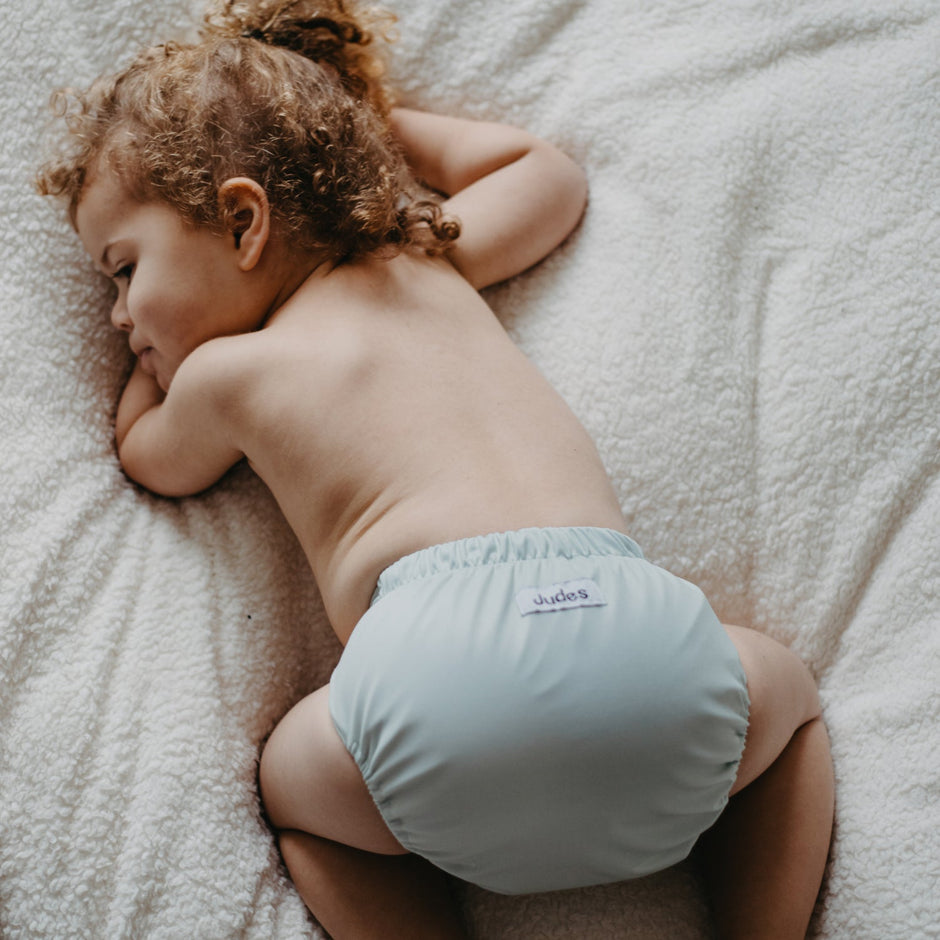Diaper Dermatitis: Symptoms, Causes, and Treatment
Updated on:
Diaper rash is not only unpleasant for our little ones but is sometimes really hard to get rid of. We have gathered the most helpful tips for combating and, even better, for the prevention of diaper rash.
What is diaper rash – Symptoms
There are two types of diaper rash. The non-contagious, ammoniacal diaper rash or diaper dermatitis is identified by red spots and welts and/or raw, partially scaly patches on the bottom. The rash can be quite unpleasant for the little ones. It is painful and causes itching and burning when urinating.
Diaper rash caused by yeast or thrush is characterized by a red rash with white pustules/pimples. In contrast to ammoniacal diaper rash, thrush is contagious and further treatment should be discussed with your pediatrician.
How does diaper rash develop – Triggers/Causes
The main triggers for diaper rash are low air circulation and a moist environment. Tightly sealed disposable diapers have a negative impact on the well-being in the diaper area due to their low breathability.
Other factors such as teething and the associated "acidic" stool can irritate the sensitive baby skin and lead to a sore bottom. If your baby is already eating solid foods, their diet also plays a role, as acidic foods (e.g., tomatoes or fruits) can influence the stool.

What helps with diaper rash – Treatment
Diaper rash cream
Diaper rash makes the baby's bottom more susceptible to fungal infections, which is why the skin should be treated as quickly as possible. There are several creams that are supposed to speed up healing. Barrier creams with zinc keep the area dry, and the zinc content accelerates wound healing. Calendula is also a proven helper against a sore bottom. Additionally, in pharmacies, you can find creams that include an antifungal agent for treating yeast infections.
However, keep in mind that these are (locally acting) medications and resistant strains can develop with frequent use (meaning the pathogens become insensitive to the active ingredient). Pay attention to good ingredients in creams, and you can use eco-test results for guidance.
Home remedies for diaper rash
Some home remedies can also help combat diaper rash. A sitz bath with chamomile tea can work wonderfully here. Fill the baby bathtub or sink with warm water (37°C) and a cup of chamomile tea, and let your baby sit in it for a few minutes. Dry your baby thoroughly after the sitz bath and let them kick around in the fresh air for a while.
Black tea is also a secret remedy for diaper rash. The tannins in black tea close the wound and form a protective layer on the baby's skin. Let a cup of black tea steep for ten minutes and cool. Dab the tea on the affected areas and let the skin air dry. You can repeat this with every diaper change. The tea keeps for three days in the refrigerator. Warning: black tea should not come into contact with your or your baby's clothing, as it can leave stains.
Another proven home remedy is (organic) healing wool from the pharmacy or drugstore. The wool absorbs excess moisture, and the wool fat (lanolin) soothes the irritated skin, acts calming, and supports regeneration.
Which diapers for diaper rash
Air circulation and a dry environment are the most important components for treating or preventing diaper rash. However, disposable diapers are designed to seal everything hermetically: nothing should leak, they should feel dry around the clock, require little changing, and ideally prevent unpleasant odors with artificial fragrances. The non-breathable material of disposable diapers hinders the necessary air circulation needed for the healing of diaper rash or its prevention.
Cloth diapers, on the other hand, are particularly well-suited for preventing diaper rash. With Judes, you have come to the right place, and our cloth diapers will protect you from these issues. Many parents tell us that since using our cloth diapers, they have no more problems with diaper rash or thrush. This is because our diapers are particularly breathable. We achieve this through two technical innovations:
-
We use particularly breathable organic cotton for the inner diaper. We use a very thin yet extremely tightly woven cotton twill. This combines several advantages: it fits snugly, is highly absorbent, and breathable. In Europe, we have not yet found a supplier who uses a comparable twill.
-
We utilize at least 10 overlapping layers of this cotton twill. This creates spaces where air can circulate. When using Judes, we recommend not using any ointment for the baby's bottom – it is simply not necessary since the skin barrier is not compromised. The bottom retains its natural temperature and remains healthy!
Did you also know that disposable diapers often contain a lotion that frequently includes fragrances and petroleum-based paraffins? This is necessary to prevent the skin from drying out due to the use of disposable diapers. Therefore, it may happen that when switching from disposable to Judes cloth diapers, your baby might temporarily experience dry skin. However, after the transition, the skin is ready for "self-care" again and stabilizes.

Preventing diaper rash
Ideally, diaper rash should never occur in the first place. Just follow a few tips and, hopefully, your baby will be rid of the unpleasant diaper rash for good. As already mentioned, cloth diapers are excellent for preventing diaper rash.
In addition, you should give your baby as much diaper-free time as possible. A comfortable room temperature and baby leggings will keep your child warm during this time. You will see that your baby thoroughly enjoys this time of freedom. It's best to place a muslin cloth underneath to catch any urine and/or stool.
Also, make sure to change your baby's diaper often enough. This keeps the diaper area dry and prevents the development of diaper rash. Clean the bottom thoroughly after every bowel movement with our reusable washcloths and clear water, and avoid using wet wipes. These contain unnecessary chemicals and preservatives—yes, even those labeled as "gentle" or "natural"—which can irritate baby skin. If the baby's bottom needs extra care, you can simply add one or two drops of almond oil to the wash water. Pat the baby's bottom thoroughly dry after cleaning.
When to see a pediatrician for diaper rash
If the symptoms do not improve within a few days, please contact your pediatrician. This way, fungal or other infections can be ruled out. A fungal infection should be treated as quickly as possible, so visit a doctor immediately if your child is affected. If there are blisters or bloody spots, consult a doctor or midwife as soon as possible.

